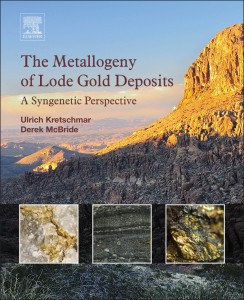Review – The Metallogeny of Lode Gold Deposits: A syngenetic perspective
The Metallogengy of Lode Gold Deposits: A syngenetic perspective is a comprehensive study of gold deposits, including field studies, geochemistry and structural overprinting with many examples of Canadian lode gold deposits.
 The book mentioned here is designed to provide geologists with the tools to develop comprehensive exploration and prospect evaluation approaches and help ensure that all important facets of geology are included.
The book mentioned here is designed to provide geologists with the tools to develop comprehensive exploration and prospect evaluation approaches and help ensure that all important facets of geology are included.
This book is the product of a century’s worth of experience by two Canadian exploration geologists. The late Ulrich Kretschmar saw the first clues in the conformable nature of the quartz veins in the shore line rocks of Eastern Nova Scotia in the 1970s.
Derek McBride’s 1975 mapping of the nearby Ecum Secum map area defined a distinct section of the Meguma Group which contained all the gold prospects. This host stratigraphic section could be differentiated by the presence of disseminated ankerite and 1-4cm pyrite crystals.
Later work by both authors in the Beardmore-Geraldton Greenstone Belt of Ontario demonstrated similar relationships between gold mineralization.
Kretschmar worked on conformable “vein” systems establishing the relationships with the host rocks and identifying a “gold cycle.” He has demonstrated that lamprophyres were later and cross-cutting, and bore no relationship to the formation of the gold mineralization.
He stressed the field relationships and used his doctoral experience in geochemistry from the University of Toronto under Dr. S.D. Scott to show that ocean-floor vent systems could produce the conformable gold mineralization.
McBride added the detailed structural deformation of the deposits with their host rocks. He had the advantage of many years’ experience in structural analysis of mineral deposits follow ing his 1976 doctoral study on the structural and stratigraphy of the Heath Steele Mines volcanogenic massive sulphide deposits.
In this study, he demonstrated that the mineralization was syngenetic and was deformed the same as the surrounding host rocks without any suggestion of selective remobilization.
Kretschmar continued to investigate the settings of gold deposits and had developed what he called “a gold cycle;” this idea permitted one to determine the facing direction of a rock sequence from vein information.
Meanwhile, McBride gained experience in evaluating mines by field and underground analysis. His study of the Northern Empire Mine produced a model for syngenetic gold deposition in a greenstone belt and developed guidelines for selecting target areas in under explored greenstone belts.
His application of this model, lead to the 1988 discovery of the Nugget Pond Gold Mine in the Betts Cove Ophiolite Complex on the Baie Verte Peninsula of Newfoundland.
Kretschmar presented his views many times over the years and decided to present them as a book.
Unfortunately, Kretschmar passed away suddenly in December 2014. McBride was asked by Elsevier to complete Kretschmar’s work.
The final product is a book that encompasses all aspects of gold deposit formation and subsequent deformation. Deposition is discussed on terms of gold and silica geochemistry, plus the observations of ocean-floor geothermal systems including the presence of carbon (graphite) found in many lode gold deposits.
Overprinted on these systems is the history of structural deformation. Evidence is presented that shows the lode gold deposits were deformed by the initial regional deformation that produced the present steep dips.
The evidence also shows that the “shear zones,” if present, are later structures that deform the deposits and regional deformation. Examples are presented that show that remobilization of gold or other metals does not occur in significant amounts during the burial or deforming events.
Finally, numerous examples from the authors’ work and the literature show that these lode gold deposits are parallel to the bedding in the rocks, show the effects of regional deformation, and have a strong commonality with volcanogenic massive sulphide deposits.
Thus, the syngenetic model can equally be applied to gold exploration. The discovery of the Nugget Pond deposit resulted from target area selection and exploration techniques of this model.
The authors’ hope is that their colleagues will find this study beneficial.
Contact Derek McBride at: dmcbgms5@yahoo.com.





Comments